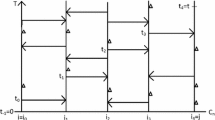Abstract
This paper gives a new, simple proof of the known fact that for contact processes on general lattices, in the subcritical regime the expected number of infected sites decays exponentially fast as time tends to infinity. The proof also yields an explicit bound on the survival probability below the critical recovery rate, which shows that the critical exponent associated with this function is bounded from below by its mean-field value. The main idea of the proof is that if the expected number of infected sites decays slower than exponentially, then this implies the existence of a harmonic function that can be used to show that the process survives for any lower value of the recovery rate.
Similar content being viewed by others
References
Aizenman, M., Barsky, D.J.: Sharpness of the phase transition in percolation models. Commun. Math. Phys. 108, 489–526 (1987)
Aizenman, M., Jung, P.: On the critical behavior at the lower phase transition of the contact process. Alea 3, 301–320 (2007)
Athreya, S.R., Swart, J.M.: Survival of contact processes on the hierarchical group. Probab. Theory Relat. Fields 147(3), 529–563 (2010)
Bezuidenhout, C., Grimmett, G.: Exponential decay for subcritical contact and percolation processes. Ann. Probab. 19(3), 984–1009 (1991)
Duminil-Copin, H., Tassion, V.: A new proof of the sharpness of the phase transition for Bernoulli percolation and the Ising model. Commun. Math. Phys. 343(2), 725–745 (2016)
Duminil-Copin, H., Tassion, V.: A new proof of the sharpness of the phase transition for Bernoulli percolation on \(\mathbb{Z}^d\) (2015), arXiv:1502.03051 (to appear in L’Enseignement Mathématique, preprint)
Grimmett, G.: Percolation. Grundlehren der Mathematischen Wissenschaften, vol. 321, 2nd edn. Springer, Berlin (1999)
Liggett, T.M.: Interacting Particle Systems. Springer, New York (1985)
Liggett, T.M.: Stochastic Interacting Systems: Contact, Voter and Exclusion Processes. Springer, Berlin (1999)
Menshikov, M.V.: Coincidence of the critical points in percolation problems. Sov. Math. Dokl. 33, 856–859 (1986)
Sturm, A., Swart, J.M.: Subcritical contact processes seen from a typical infected site. Electron. J. Probab. 19(53), 1–46 (2014)
Swart, J.M.: Extinction versus unbounded growth. Habilitation Thesis of the University Erlangen-Nürnberg (2007). arXiv:math/0702095v1
Swart, J.M.: The contact process seen from a typical infected site. J. Theoret. Probab. 22(3), 711–740 (2009)
Author information
Authors and Affiliations
Corresponding author
Additional information
Work sponsored by Grant 16-15238S of the Czech Science Foundation (GA CR).
Appendix A: Transformation of submartingales
Appendix A: Transformation of submartingales
Let \(\mathcal{S}\) be a countable set and let G be a so-called Q-matrix on \(\mathcal{S}\), i.e., \((G(x,y))_{x,y\in \mathcal{S}}\) are real constants such that \(G(x,y)\ge 0\) for \(x\ne y\) and \(\sum _{y\in \mathcal{S}}G(x,y)=0\). For any real function f on \(\mathcal{S}\), we write
whenever the infinite sums are well-defined. Then G is the the generator of a (possibly explosive) continuous-time Markov chain \((X_t)_{t\ge 0}\) in \(\mathcal{S}\). A function h such that \(Gh\ge 0\) is called subharmonic. The following simple lemma says, roughly speaking, that an unbounded, nonnegative subharmonic function that has a sufficiently positive drift and not too large fluctuations can be transformed into a bounded subharmonic function.
Lemma 3
(Transformation of submartingales) Let h be a real function on \(\mathcal{S}\) and let \(\varepsilon >0\). Then the function
satisfies \(Gf_\varepsilon \ge 0\) if and only if
where
Proof
Let \(g_\varepsilon (z):=\varepsilon ^{-1}(1-e^{-\varepsilon z})\) \((z\in {\mathbb {R}})\). Then, for any \(z,z_0\in {\mathbb {R}}\),
It follows that
which is nonnegative if and only if (34) holds.
Rights and permissions
About this article
Cite this article
Swart, J.M. A simple proof of exponential decay of subcritical contact processes. Probab. Theory Relat. Fields 170, 1–9 (2018). https://doi.org/10.1007/s00440-016-0741-1
Received:
Revised:
Published:
Issue Date:
DOI: https://doi.org/10.1007/s00440-016-0741-1



